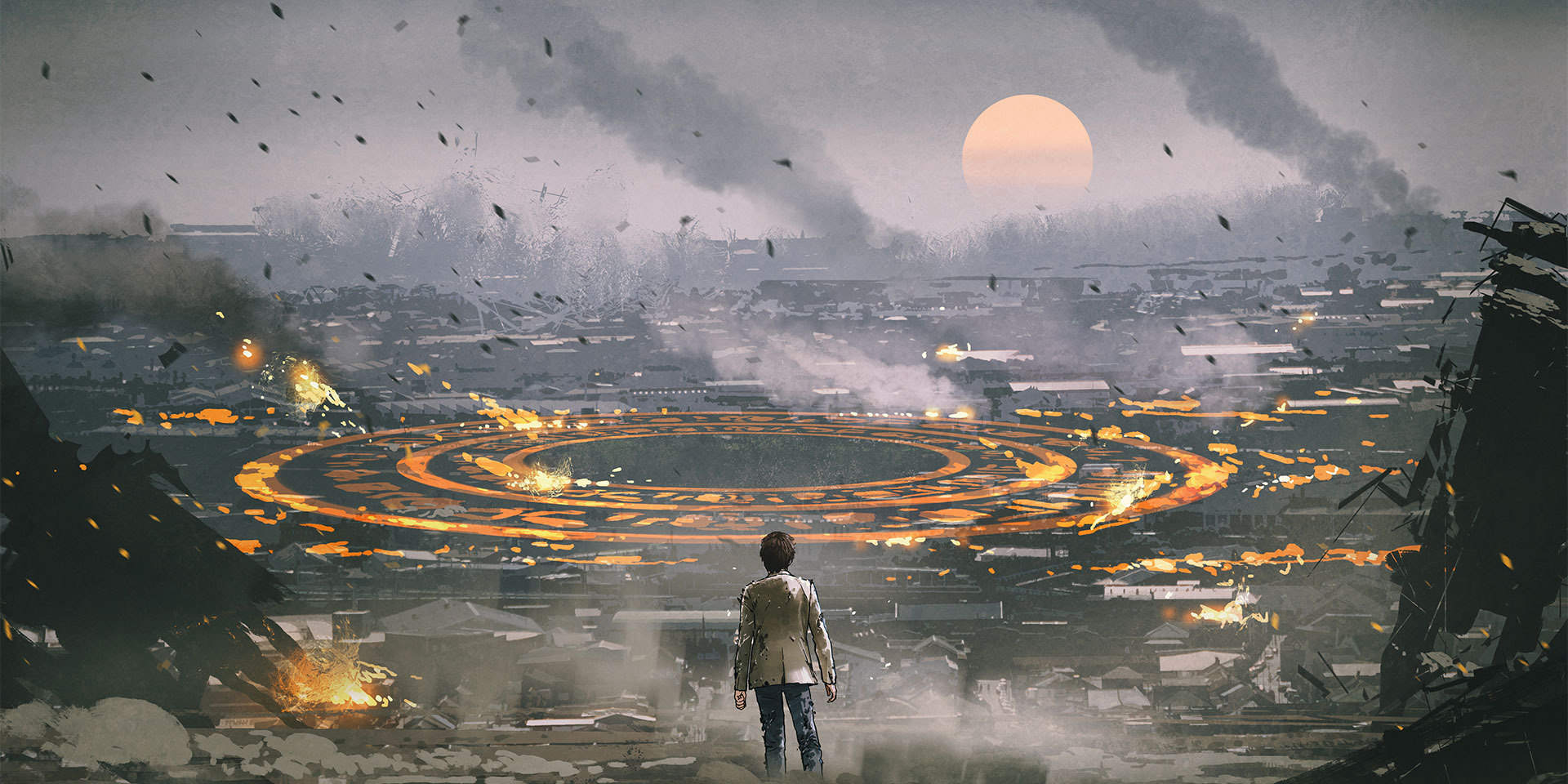Please, not now! Don’t come right now! Please… I suddenly opened my eyes in the darkness of my bedroom and, all of a sudden, the heat wave building up during the nightmare met the coolness of the night reality. You haven’t come yet… Thank you, God!
In the early 2000s, rumours that the end of the world might take place at the turn of the millennium impressed me far less than the movies in the Left Behind series, which I watched several times in a row in a year that was absolutely insignificant from a numerological point of view.
It was the first time I had seen a suspenseful screenplay of the Book of Revelation. Like any Christian believer, I believed that Christ would return to earth to recover the good people who rightfully belonged to Him. However, since I did not count myself among them, I secretly hoped that the second coming would be delayed long enough for me to experience that change of heart that would qualify me for the dustiest place on the outskirts of the Kingdom of Heaven.
I was just beginning my life, but I felt like a dying human dreaming of the inaccessible horizon of eternal life. Who could have condemned a philosophically short-sighted teenager for dreaming of living forever? It’s just that my dream wasn’t much of a fantasy. It was a recurring nightmare that starkly revealed that, although they seek to lead people to God, not every type of Christian message brings people closer to the grace they need.
Advertising for the end of the world
In a 2005 interview, Evangelical Pastor Tim LaHaye—one of the two authors of the 16-book series on which the three Left Behind (1995-2007) movies are based—stated: “God has chosen to bless this series beyond our wildest dreams.” LaHaye’s dream can also be quantified: his books have sold over 63 million copies in at least 37 countries and have been translated into no less than 33 languages.
They’ve been in the top bestselling charts for weeks, along with JK Rowling’s and Dan Brown’s books, and they’ve spread along with a myriad of related merchandise: children’s books, comics, devotionals, computer games, CDs, a website. Time and Newsweek placed the series on their covers, and Entertainment Weekly added Tim LaHaye and Jerry Jenkins to its list of “entertainers of the year” in 2003. In 2005, Business Week assessed that since the launch in 1995, the series earned over $650 million in revenue.
“Fear, of course, sells well,” says Professor Torin Monahan at the end of the above inventory, who described the Left Behind series as “the most vibrant and visible incarnation of the apocalypse industry.”[1] This is one opinion. The popularity of American apocalyptic movies did not build on the success of Left Behind, but grew steadily over the course of more than seven decades, a growth that encompassed both religious apocalypses and, so to speak, secular ones. It is therefore natural to expect that behind the presence of the end on the big screens there are several factors, not just the profitability of fear.
The social function of the cinematic apocalypse
University professor Wynn Gerald Hamonic, an expert on apocalyptic cinema, says that apocalyptic cinema is successful because it serves a growing number of social functions.[2]
First of all, says Hamonic, apocalyptic movies offer to help people gain a sense of the chaos in which mankind lives. People invest emotionally in the thought that their existence somehow falls into the decadent segment of history—not in its prosperous and progressive beginnings, but in the complete degradation that heralds the approach of a new, bright era. And this location gives meaning to the current crises. J. David Velleman described this explanation as an allusion to “our inability to keep our balance without horizons; or our desire for endings that we can outlive.”[3]
Stephen Dine Young suggested that movies equip us for life and argued that some productions (e.g., Thelma and Louise [1991], Godfather [1972]) have specific influences on behaviour, while others (e.g., Schindler’s List [1993], Don Juan DeMarco [1995]) specifically influence thinking.[4]
Many apocalyptic movies deliver the following message to the audience: “You can survive an impending cataclysm; here’s how!” when it presents characters facing life and death decisions.
Viewers can compare themselves to the characters and subtly nurture the idea that they can learn from their actions. However, one can also acquire dysfunctional tools from this comparison, for example, when realising that their problems are much more trivial than the adventures in the movie, they lose the desire to take measures to solve them.[5]
Douglas Kellner believes that Hollywood movies offer a cinematic insight into the psychological, socio-political, and ideological anatomy of American society at some point in history. In the same vein, Bloodworth and Lugo suggest that the current rise in apocalyptic films may be due to specific anxieties caused by the 9/11 attacks and exacerbated by the “us vs. them” political messages that followed the attacks.
Despina Kakoudaki followed this parallelism and spotted, for example, the idea of interracial collaboration on Independence Day (1996) shortly after the abuse experienced by African-American Rodney King; the idea of the climate threat in The Day After Tomorrow (2004) after the attacks on the World Trade Center intensified the sense of danger and political responsibility; the idea of massive floods covering cities in the movie 2012 (2009) after it became clear that political relations had influenced the scale of the disaster in the case of the oil spill in the Gulf of Mexico or in the management of the situation created by Hurricane Catrina in New Orleans.
Professor Barry Brummett from the University of Texas noted that World War I inspired more apocalyptic pop culture than World War II, although the latter was much larger and more destructive. “The key thing was that the first world war was new and different. That’s why it triggered more apocalyptic thought!”
The end-of-the-world intrigues allow producers to express their own ideologies in an artistic form. This category also includes apocalyptic movies that criticize the current socio-political order (The Day the Earth Stood Still [1951], Land of the Dead [2005]), and satires for those who fear an urgent and imminent end of the world (Dr. Strangelove Or: How I Learned to Stop Worrying and Love the Bomb [1964], This Is the End [2013]), but also the Christian apocalyptic movies that aim to produce a spiritual revival presenting the consequences of religious latency.
Only now does Left Behind become representative, not only economically, but also because it incorporates key features of Christian movies that present a pop version of the apocalypse.
The rapture and the great tribulation
The ideology of the vast majority of American Christian apocalyptic productions is based on the vision that a Scottish woman, Margaret MacDonald, claimed to have had in 1830. The woman said she saw Christ saving believers before a period of seven years of persecution, after which He returns to reign in peace for 1,000 years.
This interpretation of the end time was massively popularized in the nineteenth-century English-speaking world by Anglo-Irish preacher John Nelson Darby. Darby believed that those who are true believers will be “taken to heaven” (transplanted from Earth to Heaven) before the “great tribulation” (a time of global crisis characterized by disaster, famine, war, and suffering that will destroy most life on Earth before the return of Jesus Christ).
Christian apocalyptic movies generally outline the intrigue around the experience of characters who missed the “rapture” and who, faced with the “great tribulation,” receive a final period of grace in which they can decide if they want to dedicate themselves to God (and be saved) or if they receive the mark of the Beast (and save their physical life, but lose their spiritual one).
The Antichrist, or the Beast, is the main negative character, and the theme of the Beast’s number represented by an electronic chip appears in many of these movies, which partly explains its popularity to this day.
Before Left Behind became a phenomenon, the movie A Thief in the Night caused a stir in 1972 with the same story line. “The concept was so powerful that it became the most publicized, most watched, and most rented Christian film in the thirty-five year history of the industry, with an estimate that more than two million people converted immediately after watching the film,” Wynn Gerald Hamonic says. Nevertheless, both productions received the same criticism, valid for the entire plethora of Christian-apocalyptic movies: they traumatize young viewers and manipulate them into a conversion out of fear.[6]
Wise after the event
The movie A Hidden Life [2019] tells the true story of Austrian farmer Franz Jägerstätter, who, led by his conscience, opposed taking the oath of allegiance to Adolf Hitler during World War II. One might say that the movie is Franz’s apocalypse, whose depth is worth analysing, but what is relevant for our subject is that Jägerstätter, who was a devout Christian, came to believe that Hitler was the Antichrist. In Left Behind, the Antichrist is the Romanian Nicolae Carpathia, an anything but subtle reference to Nicolae Ceaușescu. This invites introspection with an enlarged frame.
In the years after the fall of communism, Romania experienced a religious revival which all Christian cults nostalgically long for today. Part of this revival was a natural interest in end-time prophecies. The conversion of a significant number of believers is due in part to a seminar teaching how to decipher John’s Apocalypse and the book of the prophet Daniel. Some have discovered, through those forays into prophecy, a higher sense of their existence in the world that gave them the courage to believe.
Others, however, remained stuck in a post-revolution interpretation of the Apocalypse, influenced by American folklore, which is inconsistent even with the theology it declaratively acknowledges, and perhaps with some viral fake news. The difference between the two categories is, among other things, fear.
Fear disintegrates the soul. “He who falls prey to fear usually risks disintegration,”[7] historian Jean Delumeau says. The Bible adds clarity here: “There is no fear in love.” And then, if Christ is love, and “apocalypse” means the “revelation” of Christ, wouldn’t it be possible for the cinema industry to innovate its apocalyptic discourse, giving it back its true essence? A Hidden Life succeeds in this, even without microchips. So, the American film industry was able to offer something else for a change. How about we leave the rest behind?
Alina Kartman is a senior editor at Signs of the Times and ST Network.



















